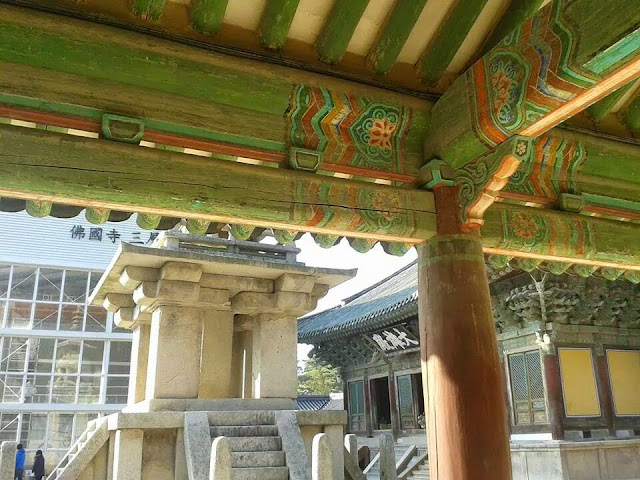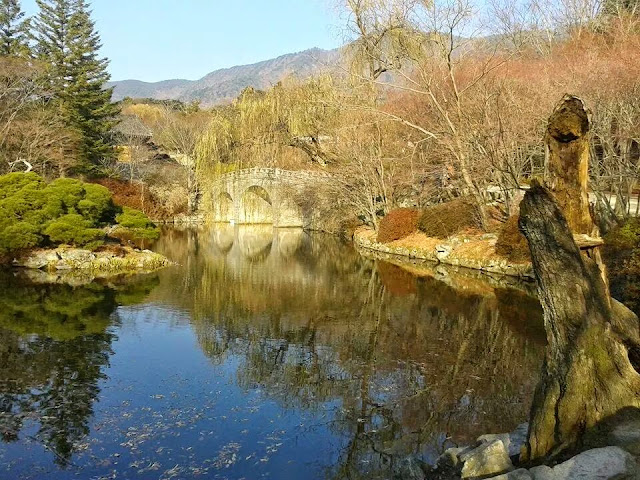Bulguksa is located on the slopes of mount Toham (Jinheon-dong) Gyeongju.
It is a head temple of the Joyce order of Korean Buddishim and encompasses seven National treasures of South Korea.
The temple is classified as Historic and Scenic Site No. 1 by the South Korean government.
Bulguksa is a large complex of shrines and pagodas built as early as 535 AD and has survived a number of fires and wars.
It also houses traditional Buddhist Art during the Silla Kingdom. It is positioned at the slopes of Mt. Tohamsan which is also quite near from Seokguram Hermitage.
Bulguksa is open at 7AM until 5:30PM and adult admission is 4,000 Won.
To go to Bulguksa you can take a Gyeongju Intercity Bus numbered 10 or 11.
The bus ride usually takes about 30 minutes if there is no traffic but I advise going on a weekday to avoid the flock of tourists
The entrance to Bulguksa temple
Two of the Sacheonwang, or Four Heavenly Kings, guard the entrance to the temple.
They are the protect the world and fight of evil, and each can command a legion of supernatural creatures to protect the Dharma if need be.
Bow to each side before moving on.
Once you reach the main courtyard you will find a photo guided map that outline the 11 important structures of the temple.
If you struggle to understand korean hangual then a free English tour guide is provided if you need one.
Once you enter the main entrancd you wil arrive closely at one of the most picturesque points of Bulguksa’s architecture.
The Bulguksa’s stairways which is also considered as one of the official treasures of Bulguksa.
The stairway is 33 steps high, corresponding to the 33 steps to enlightenment.
The lower portion is Cheongungyo (청운교, Blue Cloud Bridge). The upper portion is called Baegungyo (백운교, White Cloud Bridge).
The stairway leads to Jahamun (자하문, Purple Mist Gate), which then goes to the main hall. These stairways symbolize a person’s path from the worldly desires to the spiritual realm of Buddha. A lot of tourists were taking pictures of these stairs and unfortunately you can’t go up to the main hall using these stairs .
You can drink the clean spring water that flows through the mountains down in to Bulguksa temple.
Entrance to the court yard.
Behind the main hall is the meditation hall Museoljeon (무설전, Hall of No Words). The name was quite interesting as it was named after the saying that Buddha's teachings cannot be taught by mere words alone. It is one of the oldest buildings in the complex. Prayer halls are also found near here and there would be an old lady guarding them that would prohibit you from taking pictures.
Exploring the site of the temple, I reached the Geugnakjeon.
In Korea tradition, pig is an animal symbolises wealth and good fortune.
It is also believed that the animal drives away the evil spirits
The golden pig statue was placed in front of the Geunakjeon.
It is said that those who touch it will be lucky and bless with good fortune.
So don’t forget to try this tradition and see if you’ll get lucky!
If I have to recommend only one temple that you must visit during your trip to South Korea, it will be this temple. I’d say that is imperative that everyone visiting Gyeongju go to Bulguksa and it is definitely not to be missed. The beautiful garden, meticulous set-up of the temple’s architecture, the nature that surrounds the whole temple, overwhelming views, and the serenity of the place are the points I absolutely loved.





































No comments:
Post a Comment